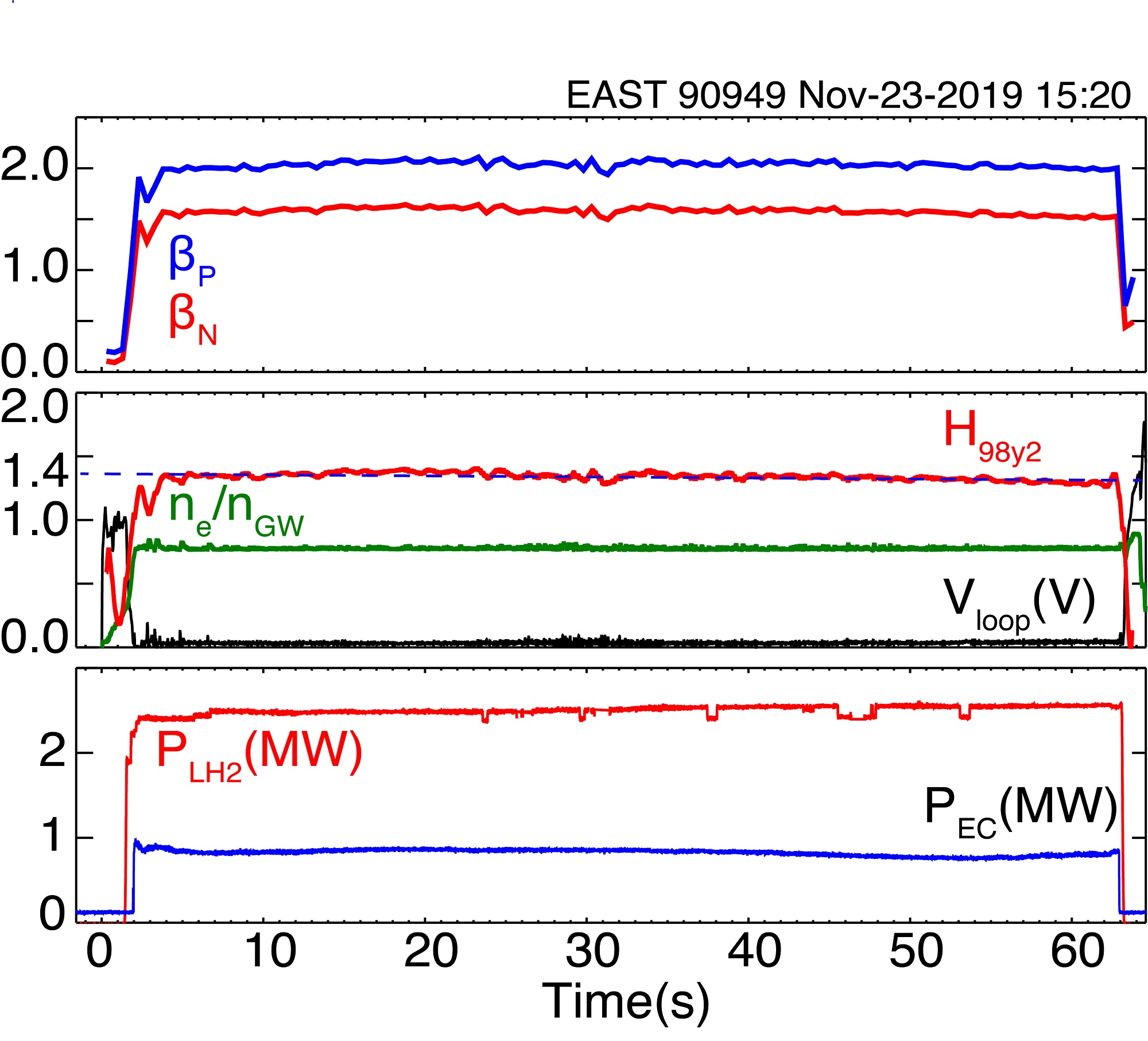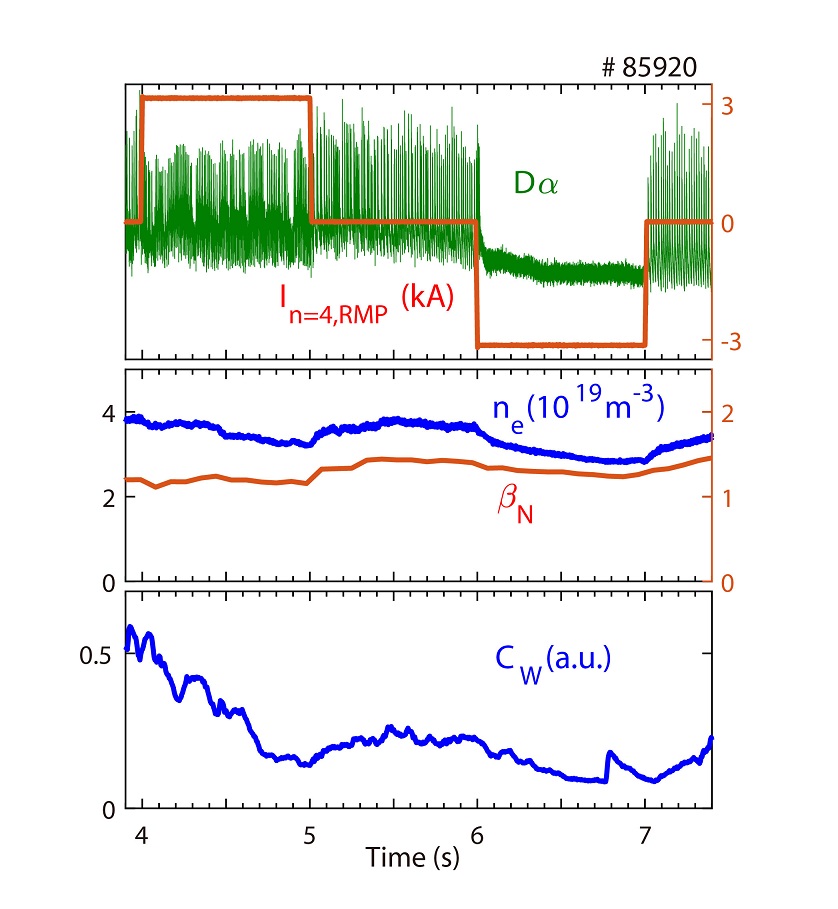Speaker
Description
Since the last IAEA-FEC, the EAST research programme has been, in support of ITER and CFETR, focused on development of the long-pulse steady-state (fully non-inductive) high beta H-mode scenario with active control of stationary and transient divertor heat and particle fluxes $^{[1]}$. The operational domain of the steady-state H-mode plasma scenario on EAST has been significantly extended with the ITER-like configuration, plasma control and heating schemes. Several important milestones on the developments of the high beta H-mode scenario and its related key physics and technologies have been achieved.
-
A minute time scale long-pulse steady-state high beta H-mode discharge (shown in figure 1) with the major normalized plasma parameters similar to the design of the CFETR Phase-III 1GW fusion power operation scenario ($\beta_P$ ~ 2.0, $\beta_N$ ~ 1.6, $f_{bs}$ ~ 50%, $H_{98(y2)}$ > 1.3 at $q_{95}$ = 6.5~7.5) has been successfully established and sustained by pure RF heating on EAST with the ITER-like tungsten divertor $^{[2]}$, as shown in figure 1. The important feature of this high beta H-mode plasma scenario is that, due to the stabilization effect of the Shafranov shift on the plasma turbulence, a higher $\beta_P$ results in a better plasma confinement as shown in figure 2. Further simulation suggested that a high density gradient promotes the ITB formation in high $\beta_P$ plasmas, which might further benefit the development of this high beta plasma scenario towards a high density regime.
-
Active control of divertor radiation has been successfully integrated into the high beta H-mode ($\beta_P$ ~ 2.5, $\beta_N$ ~ 2.0, $f_{bs}$ ~ 50%) plasma scenario without a degradation of the plasma confinement ($H_{98(y2)}$ > 1.2) at high density ($n_e$/$n_{GW}$ ~ 0.7) and moderate edge safety factor ($q_{95}$ ~ 6.7) $^{[2]}$. The peak heat flux on the tungsten divertor was reduced by ~30% with active impurity seeding of a mixture of 50% neon and 50% deuterium. The high-Z impurity concentration in the plasma core has been well controlled in a low level by applying the on-axis ECRH and reducing the fast ion losses through beam energy optimization.
-
The grassy-ELM regime has been extended to the normalized parameter space designed for the CFETR 1GW fusion power operation scenario. This regime exhibits good compatibility with high $f_{bs}$ and fully non-inductive operation, being characterized by a low pedestal density gradient and a wide pedestal, which prevents large-ELM crashes due to an expansion of the peeling-ballooning boundary after the initial pedestal collapse, indicated by BOUT++ nonlinear simulations. High separatrix density makes this regime especially suitable for operation with divertor detachment. Several feedback control schemes have been developed to achieve sustained detachment with good core confinement $^{[3]}$. This includes control of total radiation power, target electron temperature, and particle flux measured by divertor Langmuir probes or a combination of the control of target electron temperature and AXUV radiation near the X point. Integration of these detachment feedback control schemes with the grassy-ELM regimes and the high $\beta_P$ scenario has been demonstrated with neon seeding, which provides an integrated high beta scenario applicable to long-pulse operation $^{[4]}$.
-
ELM suppression has been achieved using various different methods on EAST. Full suppression of ELMs has been demonstrated, for the first time, for ITER-like low torque injection plasmas by using n=4 resonant magnetic perturbations (RMPs) $^{[5]}$. A moderate reduction (~5%) of the energy confinement has been observed together with significant reduction of both the plasma density(20%)and the Tungsten concentration (a factor of 2) during ELM suppression. The ELM suppression window agrees well with the prediction by MARS-F modelling. Robust ELM suppression by Boron powder injection without confinement degradation or even with confinement improvement has been achieved in a wide parameter range. EHO-like edge coherent modes were excited during the ELM suppression phase by Boron powder injection. In addition, simulation results from BOUT++ confirm that both the helical current filaments (HCF) driven by lower-hybrid waves (LHWs) and RF sheath effects on the ICRF antenna contribute to ELM suppression.
-
A flowing liquid lithium (FLiLi) limiter plate has been successfully assembled and tested in EAST for the first time. This plate was designed based on the concept of liquid metal infused trenches (LiMIT), which is using thermoelectric MHD to drive liquid Li flow along the surface channels. The preliminary results show that with the increase of Li flow rate, the fuel particle recycling is gradually reduced, and the plasma performance is slightly improved. There was no obvious Li burst and limiter damage even at a high injection power of 5.5 MW. In addition, ELM mitigation was observed with FLiLi operation.
-
For the first time, EAST has been operated with helium to support the ITER needs. The H-mode power threshold in a helium plasma is found to be 1.2-2.2 times higher than the scaling law in deuterium plasma with pure RF-heating $^{[6]}$. The $C_{He}$ plays a crucial role in determining the energy confinement and pedestal characteristics in helium H-mode plasmas. Divertor detachment is more difficult to achieve in He than in D. The control of divertor heat loads and W sources is achieved by RMP along with neon impurity seeding. The inter-ELM W erosion rate in He is about 3 times that in D with similar divertor conditions, while the intra-ELM W sputtering source shows a strong positive correlation with the ELM frequency $^{[7]}$.
-
A new lower tungsten divertor with a higher closure has been designed and to be installed on EAST in 2020. Several key subsystems, including the heating & current drive, cryogenic, plasma control and diagnostics will be upgraded accordingly for achieving the next milestones i) >400s long-pulse H-mode operation with ~50% bootstrap current fraction, and ii) demonstration of power exhaust at ~10 MW power injection for >100s.
Reference:
1) B. N. Wan et al 2019 Nucl. Fusion 59 112003
2) X. Z. Gong et al 2020 this conference
3) L. Wang et al 2020 this conference
4) G. S. Xu et al 2020 this conference
5) Y. W. Sun et al 2020 this conference
6) B. Zhang et al 2020 this conference
7) R. Ding et al 2020 this conference



| Affiliation | Institute of Plasma Physics, Chinese Academy of Sciences, Hefei 230031, China |
|---|---|
| Country or International Organization | China |
